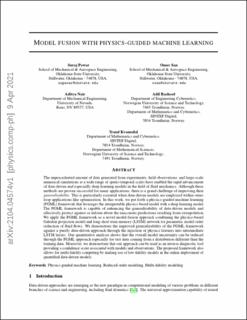| dc.contributor.author | Pawar, Suraj | |
| dc.contributor.author | San, Omer | |
| dc.contributor.author | Nair, Aditya | |
| dc.contributor.author | Rasheed, Adil | |
| dc.contributor.author | Kvamsdal, Trond | |
| dc.date.accessioned | 2022-04-21T09:38:01Z | |
| dc.date.available | 2022-04-21T09:38:01Z | |
| dc.date.created | 2021-09-03T09:05:31Z | |
| dc.date.issued | 2021 | |
| dc.identifier.citation | Physics of Fluids. 2021, 33 (6), 067123-?. | en_US |
| dc.identifier.issn | 1070-6631 | |
| dc.identifier.uri | https://hdl.handle.net/11250/2991898 | |
| dc.description.abstract | The unprecedented amount of data generated from experiments, field observations, and large-scale numerical simulations at a wide range of spatiotemporal scales has enabled the rapid advancement of data-driven and especially deep learning models in the field of fluid mechanics. Although these methods are proven successful for many applications, there is a grand challenge of improving their generalizability. This is particularly essential when data-driven models are employed within outer-loop applications like optimization. In this work, we put forth a physics-guided machine learning (PGML) framework that leverages the interpretable physics-based model with a deep learning model. Leveraging a concatenated neural network design from multi-modal data sources, the PGML framework is capable of enhancing the generalizability of data-driven models and effectively protects against or inform about the inaccurate predictions resulting from extrapolation. We apply the PGML framework as a novel model fusion approach combining the physics-based Galerkin projection model and long- to short-term memory (LSTM) network for parametric model order reduction of fluid flows. We demonstrate the improved generalizability of the PGML framework against a purely data-driven approach through the injection of physics features into intermediate LSTM layers. Our quantitative analysis shows that the overall model uncertainty can be reduced through the PGML approach, especially for test data coming from a distribution different than the training data. Moreover, we demonstrate that our approach can be used as an inverse diagnostic tool providing a confidence score associated with models and observations. The proposed framework also allows for multi-fidelity computing by making use of low-fidelity models in the online deployment of quantified data-driven models. | en_US |
| dc.language.iso | eng | en_US |
| dc.publisher | AIP | en_US |
| dc.title | Model fusion with physics-guided machine learning: Projection-based reduced-order modeling | en_US |
| dc.type | Journal article | en_US |
| dc.type | Peer reviewed | en_US |
| dc.description.version | acceptedVersion | en_US |
| dc.rights.holder | © 2021 Author(s). Published under an exclusive license by AIP Publishing. | en_US |
| dc.source.pagenumber | 067123-? | en_US |
| dc.source.volume | 33 | en_US |
| dc.source.journal | Physics of Fluids | en_US |
| dc.source.issue | 6 | en_US |
| dc.identifier.doi | 10.1063/5.0053349 | |
| dc.identifier.cristin | 1931030 | |
| cristin.ispublished | true | |
| cristin.fulltext | postprint | |
| cristin.fulltext | postprint | |
| cristin.qualitycode | 2 | |
